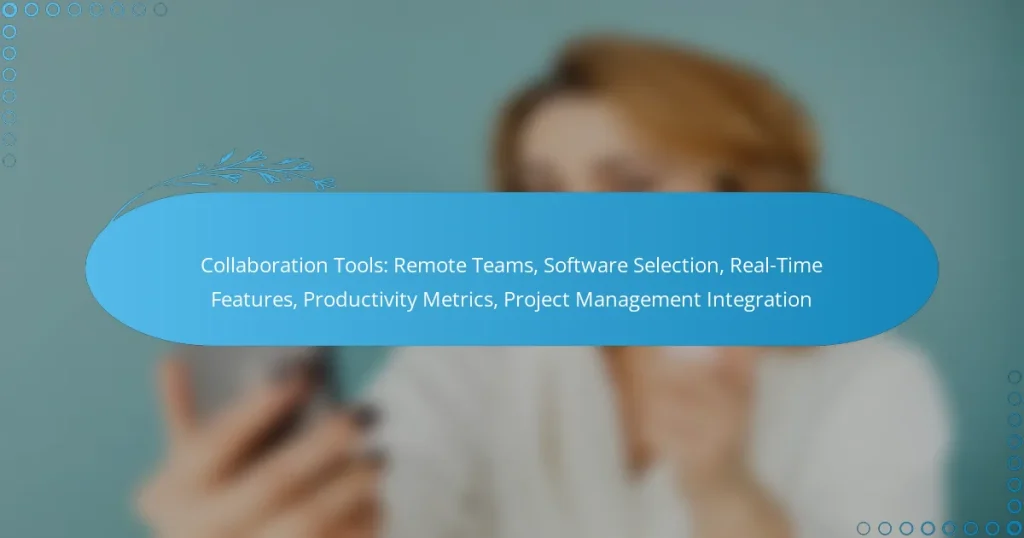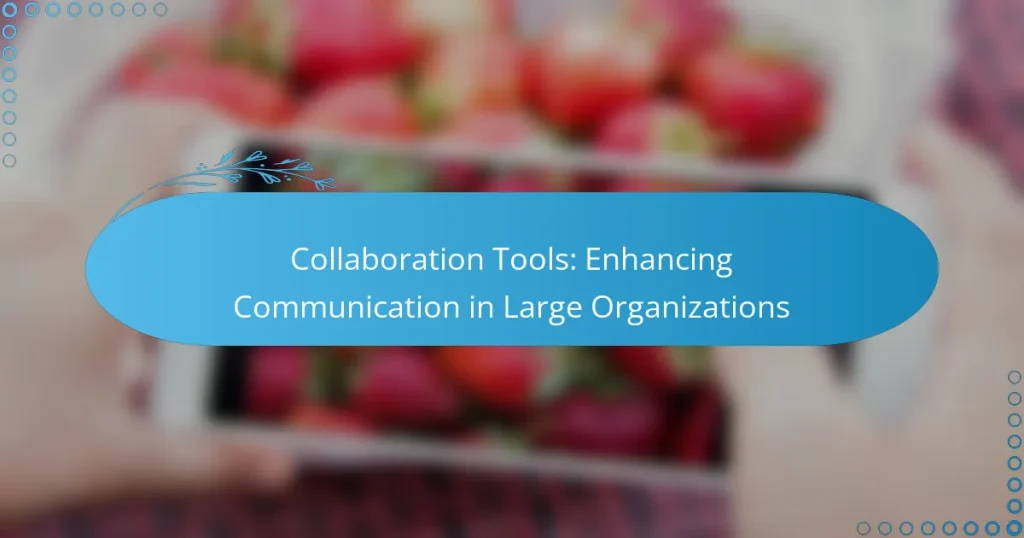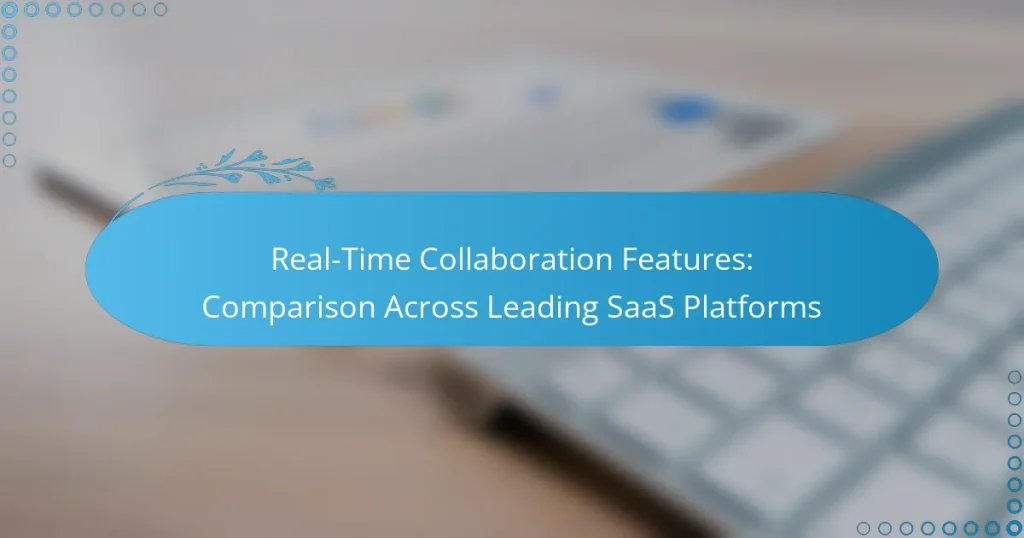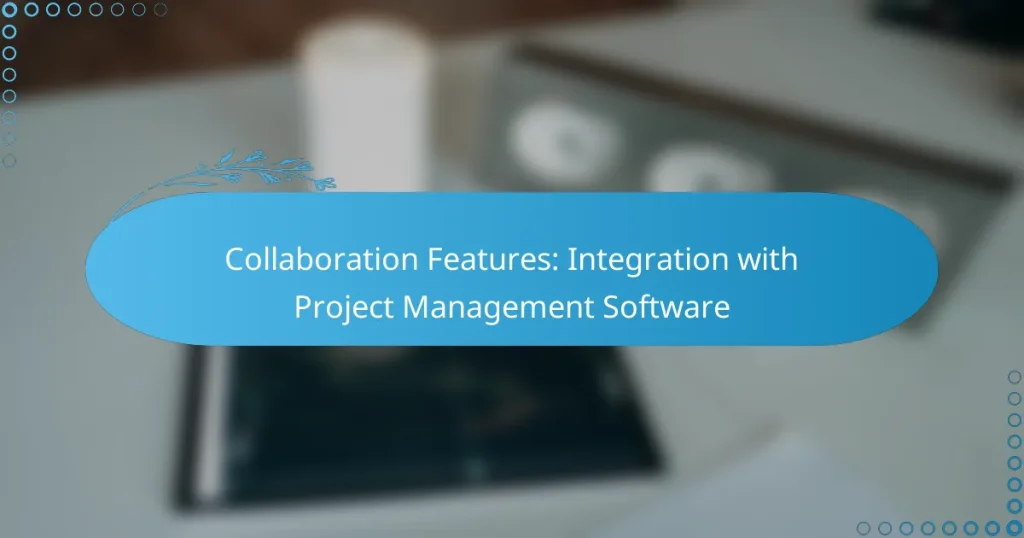SaaS business management tools play a crucial role in enhancing collaboration among teams by enabling seamless communication and integrated workflows. With platforms like Asana, Trello, Slack, and Monday.com, businesses can streamline task management and project tracking, fostering a more connected and productive work environment. By automating repetitive tasks and providing real-time access to shared resources, these tools empower teams to focus on high-value activities and improve overall productivity.
Collaboration Tools: Enhancing Communication in Large Organizations
Real-Time Collaboration Features: Comparison Across Leading SaaS Platforms
Collaboration Software: Selection Criteria and Benefits
Collaboration Tools: Impact on Team Productivity Metrics
Collaboration Tools: Best Practices for Hybrid Work Environments
Collaboration Features: Integration with Project Management Software
How can SaaS tools enhance collaboration in UK businesses?
SaaS tools can significantly enhance collaboration in UK businesses by providing seamless communication and integrated workflows. These tools enable teams to work together efficiently, regardless of their physical location, fostering a more connected and productive work environment.
Real-time communication features
Real-time communication features in SaaS tools, such as chat and video conferencing, allow team members to connect instantly. This immediacy helps to resolve issues quickly and keeps everyone aligned on project goals.
For example, platforms like Slack or Microsoft Teams enable quick messaging and video calls, which can reduce email dependency and speed up decision-making processes. Ensuring all team members are familiar with these tools can maximize their effectiveness.
Integrated project management
Integrated project management features help teams plan, execute, and monitor projects from a single platform. Tools like Trello or Asana allow users to create tasks, set deadlines, and track progress, making it easier to manage workloads and timelines.
When selecting a project management tool, consider the size of your team and the complexity of your projects. A user-friendly interface can enhance adoption and ensure that everyone stays on the same page.
Document sharing capabilities
Document sharing capabilities are essential for collaboration, allowing team members to access and edit files in real-time. SaaS platforms like Google Workspace or Dropbox facilitate easy sharing and version control, ensuring that everyone works on the latest documents.
To optimize document sharing, establish clear naming conventions and folder structures. This organization helps team members locate files quickly and reduces confusion over document versions.
Task assignment and tracking
Task assignment and tracking features enable managers to delegate responsibilities and monitor progress effectively. Tools such as Monday.com or ClickUp allow for clear visibility of who is responsible for what, helping to ensure accountability within the team.
When using these tools, regularly review task statuses and provide feedback to keep projects on track. Setting up automated reminders can also help team members stay focused on their deadlines.
What are the top SaaS business management tools for collaboration?
The leading SaaS business management tools for collaboration include Asana, Trello, Slack, and Monday.com. These platforms enhance teamwork by streamlining communication, task management, and project tracking, making it easier for teams to work together effectively.
Asana
Asana is a project management tool designed to help teams organize, track, and manage their work. It allows users to create tasks, assign them to team members, set deadlines, and monitor progress through various views such as lists, boards, and calendars.
Consider using Asana if your team needs to manage complex projects with multiple tasks and dependencies. Its integration with other tools like Slack and Google Drive can further enhance collaboration.
Trello
Trello uses a card-based system to help teams visualize their tasks and workflows. Each card represents a task and can be moved across different stages of completion, making it easy to track progress at a glance.
This tool is particularly effective for smaller teams or projects that benefit from a simple, visual approach. Trello’s flexibility allows customization with labels, checklists, and due dates, but it may lack advanced features for larger projects.
Slack
Slack is a communication platform that facilitates real-time messaging and collaboration among team members. It allows users to create channels for specific topics, share files, and integrate with other applications to streamline workflows.
Utilize Slack for instant communication and quick updates, especially if your team is remote or distributed. Be mindful of potential distractions from constant notifications and consider setting specific times for checking messages.
Monday.com
Monday.com is a work operating system that enables teams to manage projects and workflows in a highly customizable environment. Users can create boards tailored to their specific needs, track progress, and collaborate in real-time.
This tool is ideal for teams that require a high level of customization and visibility into their projects. However, it may have a steeper learning curve compared to simpler tools, so investing time in training is recommended for optimal use.
How do SaaS tools improve team productivity?
SaaS tools enhance team productivity by automating repetitive tasks, facilitating communication, and providing real-time access to shared resources. This leads to more efficient workflows and allows teams to focus on high-value activities.
Streamlined workflows
Streamlined workflows in SaaS tools reduce the time spent on manual processes. By integrating various functions such as project management, task assignments, and communication, teams can move seamlessly from one task to another without unnecessary delays.
For example, a project management tool can automatically update task statuses and notify team members of changes, ensuring everyone stays informed and aligned. This minimizes the risk of miscommunication and enhances overall efficiency.
Automated reporting
Automated reporting features in SaaS tools save time and reduce errors by generating reports without manual input. Teams can set up customized reports that pull data from various sources, providing insights into performance metrics and project progress.
Using automated reporting, a sales team can track monthly sales figures and conversion rates without spending hours compiling data. This allows for quicker decision-making and strategy adjustments based on real-time data.
Centralized information access
Centralized information access ensures that all team members can easily find and share important documents and resources. SaaS tools often include cloud storage solutions that allow for secure access from anywhere, promoting collaboration among remote teams.
For instance, a centralized knowledge base can house project documentation, guidelines, and FAQs, making it easy for team members to find the information they need without having to ask others. This reduces downtime and fosters a more independent work culture.
What features should you look for in a SaaS collaboration tool?
When selecting a SaaS collaboration tool, prioritize features that enhance teamwork and streamline communication. Key functionalities include customizable dashboards, integration with existing tools, and a user-friendly interface to ensure ease of use and adaptability.
Customizable dashboards
Customizable dashboards allow users to tailor their workspace according to their specific needs and preferences. This feature enables teams to display relevant metrics, project statuses, and tasks in a way that enhances visibility and focus.
Look for tools that offer drag-and-drop functionality, widgets, and various layout options. This flexibility can significantly improve productivity by allowing team members to prioritize information that matters most to them.
Integration with existing tools
Integration with existing tools is crucial for a seamless workflow. A good SaaS collaboration tool should connect with popular applications such as project management software, email clients, and file storage services.
Evaluate the integration capabilities of potential tools by checking their compatibility with platforms your team already uses. This can reduce the learning curve and help maintain efficiency without disrupting established processes.
User-friendly interface
A user-friendly interface is essential for encouraging team adoption and minimizing training time. Look for tools that feature intuitive navigation, clear icons, and straightforward functionalities.
Consider conducting trials with your team to assess usability. A tool that is easy to navigate can lead to higher engagement and better collaboration outcomes, as team members are less likely to encounter frustration while using the software.
How do pricing models affect SaaS tool selection?
Pricing models significantly influence the selection of SaaS tools by determining the overall cost, flexibility, and value offered. Understanding the various pricing structures can help businesses choose a solution that aligns with their budget and operational needs.
Subscription vs. one-time payment
Subscription pricing typically involves recurring payments, often monthly or annually, providing ongoing access to the software and updates. This model can be beneficial for businesses seeking predictable costs and continuous support.
In contrast, a one-time payment grants lifetime access to the software, which may appeal to companies looking for a lower long-term cost. However, this model may not include future updates or support, leading to potential additional costs down the line.
Free trial availability
Free trials allow potential users to test the software before committing financially, which can be crucial for evaluating its fit for specific business needs. Many SaaS providers offer trial periods ranging from a week to a month.
When considering a free trial, look for features that matter most to your team, and ensure you have enough time to thoroughly assess the tool’s capabilities. Be cautious of trials that require credit card information, as they may lead to unexpected charges if not canceled in time.
Scalability options
Scalability is essential for growing businesses, as it determines how easily a SaaS tool can adapt to increased usage or additional features. Look for providers that offer tiered pricing plans, allowing you to upgrade as your needs evolve.
Consider whether the tool can handle increased user numbers or additional functionalities without significant price jumps. A good SaaS solution should grow with your business while maintaining cost-effectiveness and performance.
What are the benefits of using SaaS tools for remote teams in the UK?
SaaS tools offer numerous advantages for remote teams in the UK, including enhanced collaboration, flexibility, and cost-effectiveness. These tools enable seamless communication and project management, allowing teams to work efficiently regardless of their physical location.
Improved Communication
SaaS tools facilitate real-time communication through chat, video conferencing, and collaborative document editing. This instant connectivity helps remote teams stay aligned and reduces misunderstandings that can arise from delayed responses.
For example, platforms like Slack or Microsoft Teams allow team members to share updates instantly, making it easier to coordinate tasks and share feedback. This immediacy can significantly enhance productivity and team morale.
Cost Efficiency
Using SaaS solutions can lead to substantial cost savings for remote teams. Instead of investing in expensive hardware and software licenses, teams can subscribe to cloud-based services that typically operate on a pay-as-you-go model.
In the UK, many SaaS providers offer tiered pricing plans, allowing teams to select options that fit their budget and needs. This flexibility means that smaller teams can access powerful tools without overspending.
Scalability
SaaS tools are inherently scalable, making it easy for teams to adjust their usage as their needs change. Whether a team is expanding or downsizing, they can quickly modify their subscription to accommodate new users or features.
This adaptability is particularly beneficial for startups and growing businesses in the UK, as it allows them to invest in technology that grows with them without the hassle of extensive IT infrastructure changes.
Enhanced Security
Many SaaS providers prioritize security, offering robust measures to protect sensitive data. This is crucial for remote teams that handle confidential information, as it ensures compliance with regulations such as the UK General Data Protection Regulation (GDPR).
By leveraging the security features of SaaS tools, teams can focus on their work without worrying about data breaches or loss. Regular updates and maintenance from the provider further enhance this security, ensuring that the tools remain up-to-date against emerging threats.






